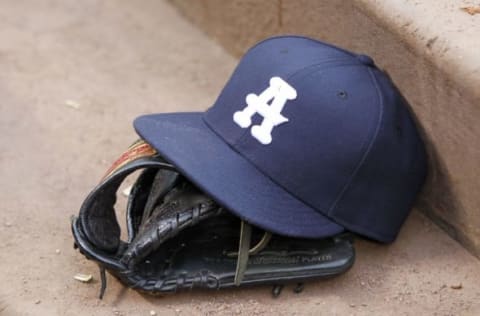Atlanta Braves Scouting Report on RHP Josh Graham


The Atlanta Braves drafted a big group of college arms in the 2015 draft with upside potential. Josh Graham was one of the biggest profile guys from that group coming into 2016. How did he fare?
Who Is He?
The Atlanta Braves selected Graham out of the University of Oregon in the 4th round in the 2015 draft. Graham was a catcher at Oregon until he couldn’t break through for a starting job and moved to the mound with some notable success for the Ducks.
With the Braves, he was assigned to advanced rookie Danville, where he made 6 appearances, 5 of them starts. He totaled 17 1/3 innings with a 2.60 ERA and 1.15 WHIP and a 3/21 BB/K ratio. That caught the eye of a number of prospect folks. John Sickels had Graham as the #20 prospect in the entire Braves system coming into the year based on good scouting reports that he received.
The Braves made the choice to make Graham a reliever going forward this season and sent him to Rome. He had some up and down time with Romw on the season, but overall, his line was solid, with a 3.40 ERA and 1.11 WHIP over 35 appearances and 42 1/3 innings with a 12/50 BB/K ratio.
Next: Graham's scouting report
Scouting Report
More from Tomahawk Take
- Atlanta Braves 2012 Prospect Review: Joey Terdoslavich
- Braves News: Braves sign Fuentes, Andruw’s HOF candidacy, more
- The Weakest Braves Homers Since 2015
- Atlanta Braves Sign Joshua Fuentes to Minor League Deal
- Braves News: New Year’s Eve comes with several questions about the 2023 Braves
Size/Delivery
Graham is listed at 6’1 and 215 pounds. That looks accurate to the eye, if even a bit on the heavy side.
Graham comes from the stretch as most relievers do. He has a pretty simple motion toward the plate, with a knee lift and solid stride toward the plate with a big follow through after he explodes toward the plate.
The notable thing in his delivery is his arm action. Graham releases the ball from about a 3/4 slot, but he gets there in a lot different way than most do. He has an arm motion that many Braves fans may remember with former hurler Tommy Hanson, seemingly shot putting the ball toward the plate.
His delivery is easy and repeatable, which is one reason you see such excellent control numbers from Graham. When he misses, it tends to be more of a matter of a ball not breaking or moving the way he expected, not a matter of being in a bad mechanical position.
Pitches
Graham works with a three-pitch mix, utilizing a fastball, slider, and a change. The fastball is fairly straight, but it does run up to 97-98 while sitting in the 93-96 range. The fastball has played up in average velocity as a pro, and I had reports of 99 this year from folks I talked with, but no radar readings in any of the games I watched ran that high.
The fastball works at its best when he is working it in the lower part of the zone, and his arm motion gives him a similar effect to a taller pitcher by giving the ball some “weight” as it comes to the plate, with most hitters getting on top of the ball.
The slider has some cut action to it at times and other times it’s more a straight slider. Interestingly, he seems to use the depth slider more as a strikeout pitch and the cut-action slider early in the count when he is seemingly looking for weak contact.
Last is the change, which he doesn’t use a ton, but it is an effective third pitch out of the bullpen. I was impressed with the way he spotted the change, and I did find that he had very good results throwing the change high as his eye-level pitch, which really seemed to tie up hitters as they were expecting a high fastball and swung either right under the pitch or way ahead of the pitch.
Video
Next: Future outlook

Future Outlook
Graham fits in line very similarly to a fellow former catcher, Jason Motte, who spent the season with the Colorado Rockies, but struggled with injuries after being expected to be the opening day closer for the Rockies before a shoulder injury flared up at the end of spring to start his injury woes for the year.
Motte similarly has a unique delivery that has allowed his raw stuff to play up, even without great movement. He does work with more of a fastball/cutter/change combination, but like Graham, he does use his 3-pitch mix in the bullpen with effectiveness.
The lack of movement on a mid-90s fastball from an arm slot of a 6′ tall guy (Graham is 6’1, Motte is 6′) does lead to some extra stress on the arm, and Motte did deal with surgery in 2013 after he had saved 42 games the year before for the Cardinals. He’s played for three teams in the three seasons since he returned from his surgery.
Next: Braves Minor League Database
It will be interesting to see how Graham does keeping his arm healthy with his unique delivery on his way up the system. Natural progression would have him in high-A in 2017, but he’s a college guy and not getting any younger (23 on opening day), so the team may choose to bump him up all the way to AA.